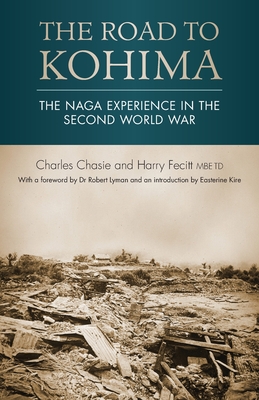The Road to Kohima: The Naga experience in the Second World War

The Road to Kohima: The Naga experience in the Second World War
The battle of Kohima, often referred to as the 'Stalingrad of the East', was the turning point of the Japanese offensive into India in 1944 during what the West calls the Second World War. A recent survey by the National Army Museum voted it Britain's greatest battle. The Road to Kohima is a unique collaboration between a senior Naga journalist and an eminent British historian, who between them have developed the thread of the Naga involvement in the Second World War. For these Nagas, living high up in the hills, war came to them. The battle, though devastating, lasted only a few months but in that time the Nagas played a key part.
The battle was fought in three stages from 4 April to 22 June 1944 around the town of Kohima, the capital of Nagaland in northeast India. From 3 to 16 April, the Japanese attempted to capture Kohima ridge. By mid-April, the small British and Indian force at Kohima was relieved. From 18 April to 13 May British and Indian reinforcements counter-attacked to drive the Japanese from the positions they had captured. The Japanese abandoned the ridge at this point but continued to block the Kohima-Imphal road. From 16 May to 22 June, the British and Indian troops pursued the retreating Japanese and reopened the road. The battle ended on 22 June when British and Indian troops from Kohima and Imphal met at Milestone 109, ending the Siege of Imphal.
Through personal stories the first part of the book illustrates the ordinary civilian experience of those caught up in the fighting and tells both how their lives were affected by it and how village life was pieced together after the battle was over. Context to these poignant tales is provided in the second part of the book, which details the military events in Kohima and the Naga participation as soldiers. Together the two halves of the book form a marvellous historical document for all who are interested in the Second World War and military history generally.
PRP: 165.33 Lei
Acesta este Pretul Recomandat de Producator. Pretul de vanzare al produsului este afisat mai jos.
148.80Lei
148.80Lei
165.33 LeiIndisponibil
Descrierea produsului
The battle of Kohima, often referred to as the 'Stalingrad of the East', was the turning point of the Japanese offensive into India in 1944 during what the West calls the Second World War. A recent survey by the National Army Museum voted it Britain's greatest battle. The Road to Kohima is a unique collaboration between a senior Naga journalist and an eminent British historian, who between them have developed the thread of the Naga involvement in the Second World War. For these Nagas, living high up in the hills, war came to them. The battle, though devastating, lasted only a few months but in that time the Nagas played a key part.
The battle was fought in three stages from 4 April to 22 June 1944 around the town of Kohima, the capital of Nagaland in northeast India. From 3 to 16 April, the Japanese attempted to capture Kohima ridge. By mid-April, the small British and Indian force at Kohima was relieved. From 18 April to 13 May British and Indian reinforcements counter-attacked to drive the Japanese from the positions they had captured. The Japanese abandoned the ridge at this point but continued to block the Kohima-Imphal road. From 16 May to 22 June, the British and Indian troops pursued the retreating Japanese and reopened the road. The battle ended on 22 June when British and Indian troops from Kohima and Imphal met at Milestone 109, ending the Siege of Imphal.
Through personal stories the first part of the book illustrates the ordinary civilian experience of those caught up in the fighting and tells both how their lives were affected by it and how village life was pieced together after the battle was over. Context to these poignant tales is provided in the second part of the book, which details the military events in Kohima and the Naga participation as soldiers. Together the two halves of the book form a marvellous historical document for all who are interested in the Second World War and military history generally.
Detaliile produsului








